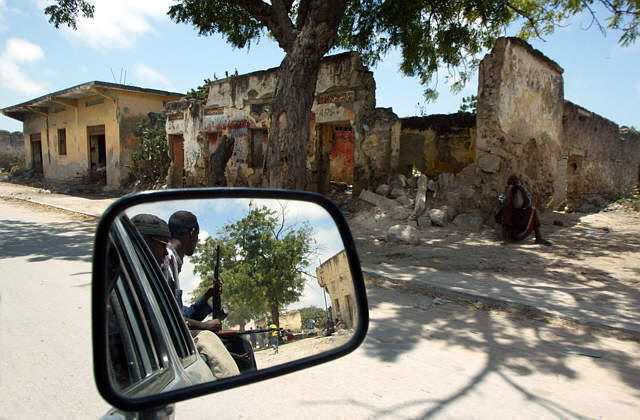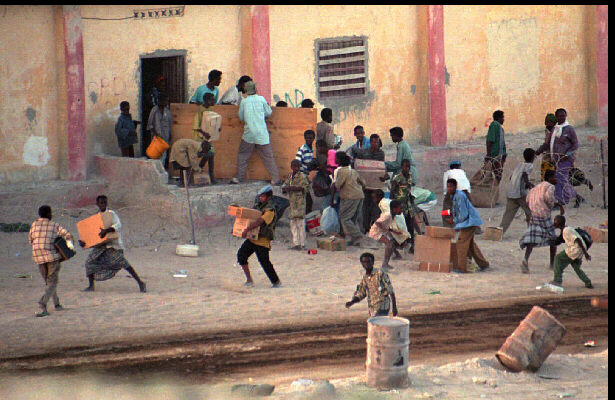| Zooming into the Past | |
|
M O G A D I S H U C I V I L W A R S
Introduction
Zooming into the 1990s interviews and statements, given by the spokespersons and leaders of Somali factions, enables us to prove that clan-animosity account of the Somali civil war has not been given the scholarly attention that its magnitude warrants, even after sixteen years of clan-warfare. This clan-animosity feeling can in fact be derived from faction joint communiqué and statements; and therefore, posting selections of these public relation statements should be a matter of concern to all Somalis – particularly, to those who are in the field of Somali Studies.
After all, clan factionalism disguised in English acronyms (formed from three or four initial letters which include the sacrosanct letter “S”) are now facts of life for Somalis. The words and deeds of the turbulent faction followers have ordained to presuppose that faction spokespersons assumed a monumental role in fuelling clan-hatred. As a result of that, the Forum rushes in to investigate and share with you excerpts of faction communiqués, hoping to find solutions to the current tragic political situation in Somalia. From our perspective, these selections are indeed those that Western scholars/(Somalists) most neglected, or could offer hints to the causes of the civil war.
M A R C H 1 9 9 0 s
Somali gunmen drive through the streets of Mogadishu
OLD MAN BEGS FOR HELP FROM SOMALI GUNMAN IN CITY OF BAIDOA, SOMALIA
A young Somali smokes and holds a weapon as he and his friends sit on a car
Children pulling a donkey cart watch a carload full of armed militiamen pass through the streets of Mogadishu
'Secret' reports allege Aideed funded by drug, welfare money
By Moira Farrow SPECIAL TO THE STAR The Toronto Star March 04, 1994
VANCOUVER -- The information is contained in federal reports released this week after a four-month battle with bureaucracy. Initially, the access office refused to release any of the reports; this week's release resulted from an appeal of that decision.
However, about three- quarters of each report has been blanked out for reasons of privacy and possible harm to "lawful investigations," according to privacy co-ordinator E. W. Aumand.
The material that has been released confirms earlier stories that described how millions of dollars in welfare money collected fraudulently by Somali refugees in Canada is being used to buy arms for Somali warlords.
One of the reports released this week is called "Operation Desert Gypsy." Labelled "Secret," it was written by an unnamed immigration intelligence liaison officer in the Toronto-Mississauga region.
"Sources report Aideed funding is derived from two sources, namely Canadian welfare and drug trafficking. Apparently fields of marijuana and poppies have been planted in the agriculturally fertile area known as the 'death triangle' around Baidoa," the report states.
It adds that, along with Somali clan loyalties, comes the "clan custom of qaaran, or monthly tithe to the clan. Individual members of each clan pay qaaran to their respective clan leaders. The amount of qaaran paid by an individual varies with his ability to pay. Those Somalis who refuse to pay qaaran are ostracized by family and clan members and are not privy to certain clan activities."
(Several Somalis interviewed last year said that they are tithed out of their welfare money to support the warlords).
After a blanked-out section, the report goes on to state that Aideed - apparently after a posting as Somali ambassador to India - "rather than return to Somalia, packed up his family and his $1.25 million in drug proceeds and flew to Los Angeles, Calif."
The report continues: "There he purchased properties in Burbank and La Barr and established his wife and family. He still sends a cheque from Mogadishu to pay his wife's property taxes in California every year."
(The Vancouver Sun reported last year that Aideed's first wife, Asli Dhubat, 59, lives near Los Angeles. Her six children, including one son who served in the U.S. Marines, live in the U.S., Canada and Europe. Aideed's second wife, Khadija Gurhan, lives with her four young children on welfare in London, Ont.)
The Desert Gypsy report also refers to a man named Abdulkadir Warsame as one of Aideed's "inner circle" and a man who would hold a key position in his regime if he seizes power.
(In an interview last year in Toronto, Warsame admitted raising funds for Aideed. He has since left Canada, leaving a large family on welfare in Ontario, and is believed to be back in Africa. One of his brothers and two of his sisters have been charged with welfare fraud and the cases are still outstanding).
The second report, called Project RAW (Refugee Abuse of Welfare), was written by immigration intelligence officers in Ontario and is almost totally blanked out.
One of the few paragraphs that can be read states that "11 of the cases we have brought to finality have cost Canadian taxpayers over $1,000,000."
The final report is called Project WARF (Welfare and Refugee Fraud). Much of this report is also blanked out, but it's the same report which was leaked to Ontario Liberal Leader Lyn McLeod last year.
However, several addenda to the original have now been released. One addendum states: "The fraud rate for multiple identity refugee and welfare fraud among Canadian resident Somalis is believed to be significantly higher than our figures would indicate."
Immigration Minister Sergio Marchi was travelling yesterday and was unavailable for comment.
VANCOUVER SUN
© Copyright 994. The Toronto Star.
'Fundamental review' of UNOSOM II follows violence: Council creates Commission of Inquiry. (UN Operation in Somalia; Security Council) (includes Secretary General Boutros Boutros-Ghali's statement on Somalia, November 9, 1993)
The UN Chronicle Vol. 31, No. 1, ISSN: 0251-7329 March 01, 1994
After intense street fighting on 3 October left 18 American soldiers dead, the United States announced its intention to withdraw all its troops from Somalia by 31 March 1994. Some other nations said they too would withdraw troops from Somalia.
Following those developments, the Security Council on 18 November decided to undertake a fundamental review of the UNOSOM II mandate by 1 February 1994. Mr. Boutros-Ghali was asked to provide an "updated plan" setting out a future strategy for UNOSOM II with regard to humanitarian, political and security activities.
On 16 November, by adopting resolution 885 (1993), the Council authorized the establishment of a Commission of Inquiry to investigate armed attacks on UNOSOM II personnel which led to casualties among them.
On 24 November, Mr. Boutros-Ghali appointed three Commission members: Matthew S. W. Ngulube, Chief Justice of Zambia, as Chairman; retired General Emmanuel Erskine of Ghana; and General Gustave Hagglund of Finland.
Pending completion of the Commission's report, the Secretary-General was requested to suspend arrest actions against those who might be implicated in the 5 June street ambush that cost 24 Pakistani peace-keepers their lives, and to make appropriate provision to deal with the situation of those already detained.
On 6 June, the Council had condemned what it called the "premeditated" attacks launched by forces apparently belonging to the United Somali Congress/Somali National Alliance (USC/SNA), led by Gen. Mohamed Farah Aidid. In resolution 837 (1993), it also reaffirmed that UNOSOM II was authorized to take "all necessary measures" against the perpetrators, including arresting, prosecuting and punishing them. The Secretary-General was asked to inquire into the 5 June ambush, with particular emphasis on the role of factional leaders involved.
On 24 August, an independent expert who investigated the incident reported that a "large and complex body of evidence" supported the claim that Gen. Aidid had not only the means, motive and opportunity to perpetrate such a crime, but that "he had that trinity uniquely".
Of 740 Somalis detained by UNOSOM II and the United States Ouick Reaction Force for their alleged involvement in attacks against peacekeepers, 698 had already been released, the Secretary-General reported on 12 November.
Resolution 886:
Mandate renewal
By unanimously adopting resolution 886 (1993) on 18 November, the Council renewed the mandate of UNOSOM II until 31 May 1994. (On 29 October, by resolution 878 (1993), the mandate had been extended until 18 November.)
The Council reminded all parties in Somalia, including movements and factions, that continued UN involvement "depended on their active cooperation and tangible progress towards a political settlement".
It urged the Somali parties to accelerate their efforts to achieve political reconciliation, peace and security, and to abide immediately by cease-fire and disarmament agreements reached in Addis Ababa on 8 January and 27 March. Those agreements established a sound basis for resolution of the problems in Somalia, the Council said.
The 15-member body emphasized the "crucial importance" of disarmament in achieving lasting peace and stability throughout Somalia. it expressed concern at the destabilizing effects of cross-border arms flows in the region, and called for their cessation. States were asked to implement fully the embargo on all deliveries of weapons and military equipment to Somalia, imposed by the Council on 23 January 1992.
Also in resolution 886, the Council condemned the continuing acts of violence and armed attacks against persons engaged in humanitarian and peace-keeping efforts, and paid tribute to the troops and humanitarian personnel killed or injured in Somalia.
It stressed the commitment of the international community to continue helping Somalia in its efforts to achieve national reconstruction and regain a normal, peaceful life.
It recalled that UNOSOM II's highest priority continued to be to support the efforts of the Somali people in promoting the process of national reconciliation and the establishment of democratic institutions.
The Council also:
v Supported ongoing diplomatic efforts to assist the UN in bringing all Somali parties to the negotiating table;
v Underscored the importance of the Somali people attaining specific goals regarding political reconciliation, in particular the early establishment of all district and regional councils and an interim national authority:
v Stressed the importance of establishing an operational police, penal and judiciary system as soon as feasible; and
v Commended the Secretary-General, his Special Representative, Admiral Jonathan Howe, and UNOSOM II personnel for their achievements in improving the conditions of the Somali people and in promoting national reconciliation and reconstruction of the country.
In Council debate, the United States said the UN Operation in Somalia was "one of the most difficult the Organization has had to confront" and had required sacrifices by many States. By passing resolution 886, the Council had demonstrated that it would not abandon Somalia, but the Somali people had to show the will and the courage to bring about true national reconciliation.
"If they are prepared to make this investment in their future, UNOSOM and the international community stand ready to give their every assistance. But if they cannot work together to solve their own problems, they cannot expect the United Nations to do it for them", the United States added.
Djibouti, a neighbouring State and a Council member, hoped that regional diplomatic efforts, led by President Meles Zenawi of Ethiopia, combined with U N efforts, would bring all parties to the negotiating table: "Somali society, which is extensively fragmented, needs to overcome its lingering ills quickly, before the pervasive international good will and patience begin to show irreversible wear and tear."
Violence, withdrawals
The Secretary-General on 12 November reported (S/26738) UNOSOM II's record of general progress throughout most of Somalia had been "seriously marred" by incidents which took place between 5 June and 3 October.
The American forces, after apprehending 24 USC/SNA supporters suspected of complicity in the 5 June attack on Pakistani peace-keepers, came under concentrated fire in and around the building they had targeted on 3 October. Eighteen American soldiers lost their lives and 75 more were wounded.
One American helicopter pilot was captured and subsequently released 11 days later, on 14 October, along with a detained Nigerian peace-keeper.
The bodies of the United States soldiers - some of which had been mutilated and dragged through the streets of Mogadishu - "were treated in a most despicable and humiliating manner", the Secretary-General stated. He also regretted that a large number of Somalis lost their lives and that "gangs" had used women and children as "human shields" while attacking UNOSOM II personnel.
Following those events, the United States reinforced its Ouick Reaction Force - deployed in support but not part of UNOSOM II. United States President Bill Clinton announced his intention to withdraw his country's forces by 31 March 1994.
"These incidents challenged the cause of disarmament and reconciliation in Somalia, created a situation of instability in South Mogadishu, and stimulated factional elements elsewhere to prepare for a future of renewed fighting", the Secretary-General said.
He was conscious that the international community could not "take for granted forever the generosity of the troop-contributing countries, their readiness to put the lives of their sons and daughters on the line in pursuit of what is perceived to be a somewhat distant and ill-defined objective".
He said that in evaluating options for UNOSOM II in the near future, account must be taken of recent developments, the most significant being the impending withdrawal of United States troops. The Governments of Belgium, France and Sweden had also said they would withdraw from UNOSOM II.
As UNOSOM II depended primarily on the United States for logistics support, its departure would create a vacuum, he stated. He invited 42 States to participate or expand their contribution to the UN operation.
In his report, the Secretary-General presented three options for the future mandate of UNOSOM II. The Council, he said, might have to choose between them "fairly soon".
The first was essentially to maintain the present mandate, as laid out in Council resolution 814 (1993) establishing UNOSOM II.
Under that option, UNOSOM II would not initiate coercive methods of disarmament, but if the USC/SNA tried to block its movements in Mogadishu or if UN forces were attacked, UNOSOM would retaliate and retain the necessary capability for coercive disarmament. Should the Council choose that option, it should retain the current troop strength - 29,284 of 12 November - and deploy an additional brigade.
Under the second option, UNOSOM II would use force only in self-defence, in accordance with traditional peacekeeping practices, and disarmament would be entirely voluntary. Troop requirements would be about 16,000.
Under option three, the mandate would be limited to controlling airports and ports in Mogadishu and other important areas, to keep supply routes open for humanitarian purposes. That option would emphasize operations in the regions, as opposed to securing Mogadishu, thus requiring a much smaller force of about 5,000.
Theoretically, there could be a fourth alternative, the Secretary-General added: complete withdrawal from Somalia. However, he rejected that possibility. "The international community must not abandon Somalia in view of the incontrovertible desire of the Somali people for the continued presence of UNOSOM II in their country", he stated. "Total withdrawal would not be a responsible act."
The Secretary-General, also in his 12 November report, welcomed the declaration of a unilateral cessation of hostilities by USC/SNA on 9 October, which "initially led to somewhat reduced tensions" in Mogadishu. However, threats by Gen. Aidid, followed by a demonstration and gunfire on 8 November aimed at preventing American and UNOSOM II humanitarian and security operations in the city, had raised "serious questions about USC/SNA's sincerity".
To build on the unilater cessation, the Secretary-General reported that UNOSOM II had established a Mogadishu Security Advisory Committee to which all factions were invited. USC/SNA boycotted the Committee meetings, except for one when its representative spoke against UNOSOM II and then left. in spite of such setbacks, the Secretary-General said UNOSOM II would "persevere in its efforts to establish a dialogue with USC/SNA".
The Secretary-General warned that it was possible that the national reconciliation process might not succeed. "In such an eventuality, the probability of a resumption of civil war in Somalia would be high." There were already reports, although not fully confirmed, of additional supplies of weapons entering Somalia.
UN efforts at encouraging Somali reconciliation was not limited to reaching out to USC/SNA in Mogadishu. UNOSOM II officials also met it leaders of sub-clans in the outlying regions.
Failed talks
Representatives of two major alliances - the Group of 12 and the Somali National Alliance (SNA) - met to discuss their outstanding disputes from 2 to 11 December at a political meeting in Addis Ababa, held at the invitation of the Ethiopian Government and with the support of UNOSOM II.
The factional representatives failed to agree on a structure for face-to-face talks between their chairmen, and the initiatives unfortunately were not successful, the Secretary-General reported (S/1994/12).
Among the divisive issues was whether or not the UN should play a role in the national reconciliation process - SNA preferred the involvement of regional powers, while the Group of 12 wanted a UN role and UNOSOM II to remain in Somalia. There were also sharp differences over the status of district and regional councils, with SNA calling for a fundamental review of their mandate.
SNA also complained that the UN was instigating the Group of 12 into excluding it from the national reconciliation process.
At a meeting in Mogadishu from 13 to 18 December, the Group of 12 issued a resolution and an interim plan of action which called for a permanent contact group to hold a dialogue with SNA to speed implementation of the Addis Ababa Agreement.
Secretary-General Boutros-Ghali visited Africa in October, discussing the Somalia situation with several leaders, including the Presidents of Djibouti, Kenya and Ethiopia, as well as with the Chairman of the Organization of African Unity (OAU), and the Secretaries- General of OAU, the League of Arab States and the Organization of the Islamic Conference.
Disarmament, famine
The Secretary-General, in his 12 November report, restated his conviction that "without effective disarmament of all the factions and warlords in Somalia, it would not be possible for the country to enjoy lasting peace and stability".
He also reported that the "most dramatic and visible change" in Somalia was the "enormous success in reducing starvation deaths and conditions of famine in the country today".
The number of refugees returning from camps in Kenya was increasing - about 70,000 Somalis in the Mombasa area had returned by boat. The refugee problem was still huge, as up to 1.7 million people had been forced to leave their homes as a result of the turmoil and the famine in Somalia, which killed an estimated 300,000 people in 1992.
In a 29 October report (A/48/504), the Secretary-General warned that encouraging developments on the humanitarian front could "quickly be reversed" unless increased assistance was provided by the international community, The response to a recent UN appeal for relief and rehabilitation had been "disappointing".
A three-day Fourth Coordination Meeting on Humanitarian Assistance for Somalia - attended by some 140 Somali delegates, as well as representatives of donor Governments, regional organizations, UN agencies and international non-governmental organizations - concluded on 1 December in Addis Ababa, Ethiopia, with the signing of a Declaration of goals and principles to be translated into a six-month plan of action.
In resolution 48/201, the Assembly on 21 December asked that Somalia receive international aid in rehabilitating its social and economic services, institution-building, and restoring civil administration to local areas.
© COPYRIGHT 1994 United Nations Publications
SOMALI GUNMEN DRIVE THROUGH THE STREETS OF THE CAPITAL MOGADISHU
Somalis loot U.N. barracks near the Mogadishu port
|
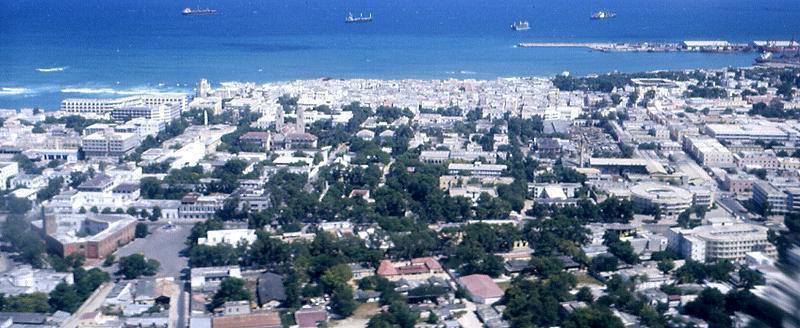
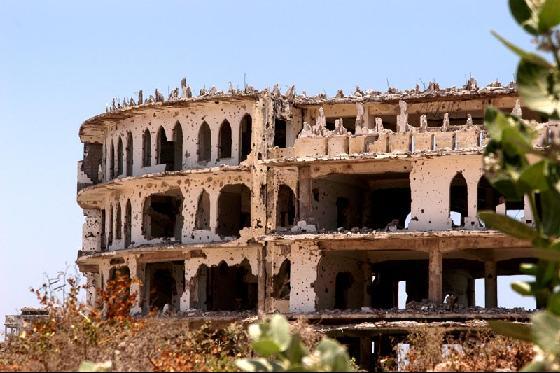
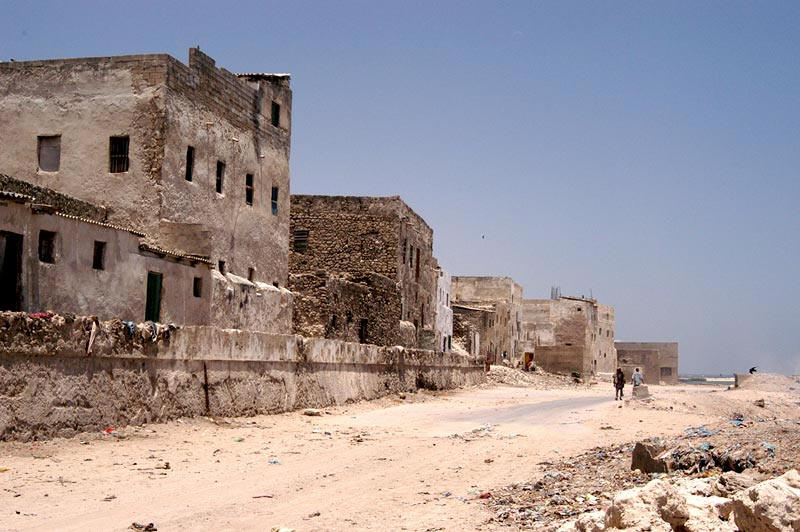
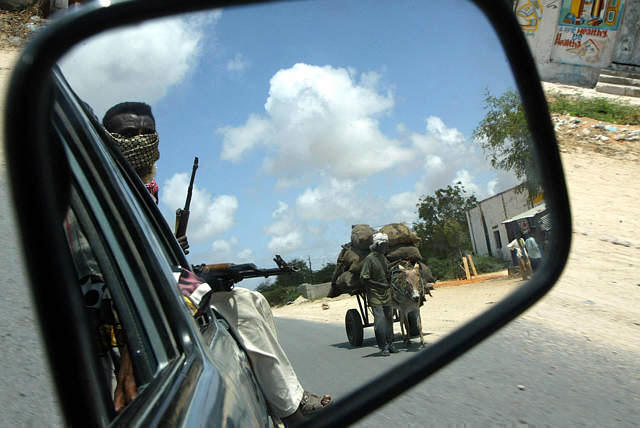
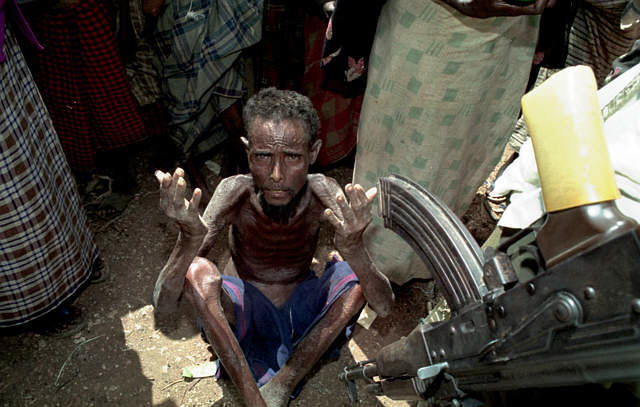
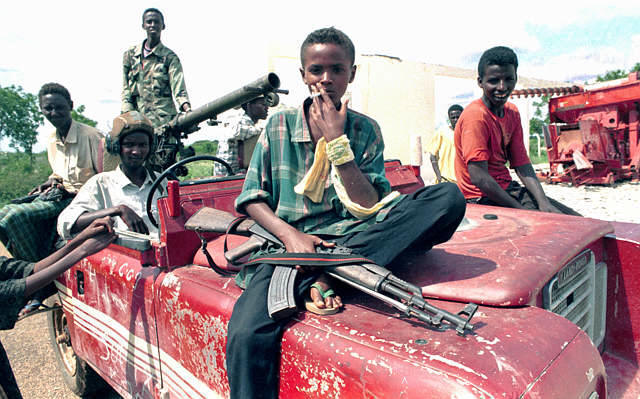
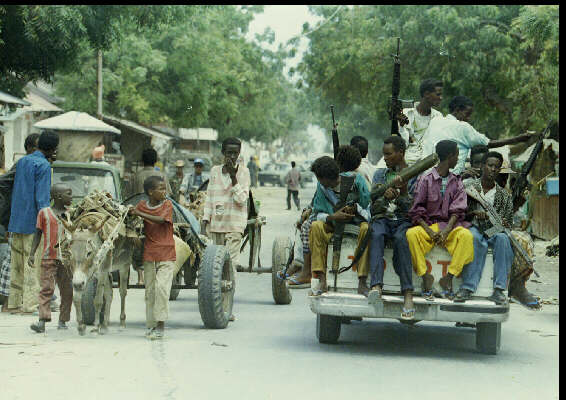
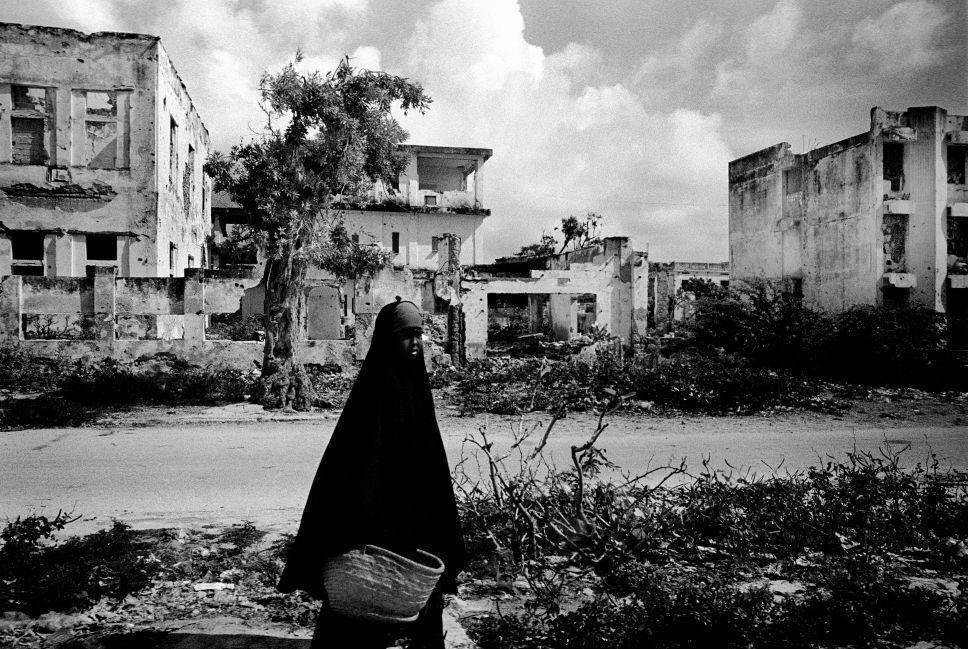
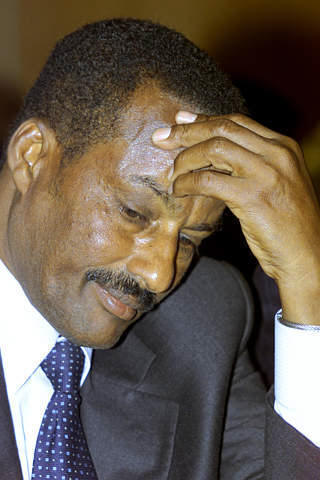
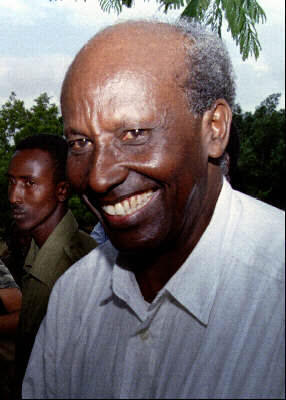
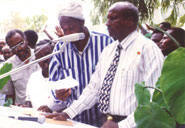
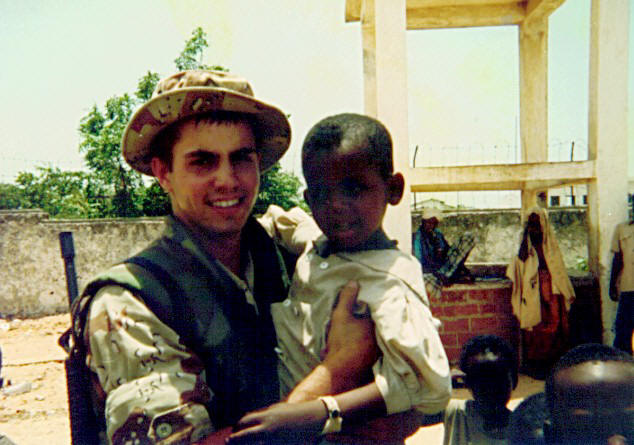 The
30,000-strong UN Operation in Somalia II
The
30,000-strong UN Operation in Somalia II